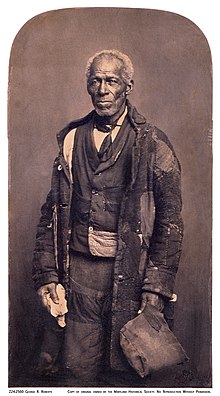George R. Roberts (privateer)
George R. Roberts (1766 – 14 January 1861) was an American privateer in the War of 1812.[1]
George R. Roberts | |
|---|---|
 Portrait of George R. Roberts by Daniel and David Bendann at H. Furlong Baldwin Library, Maryland Historical Society, Baltimore. C. 1859-1865. | |
| Born | 1766 Baltimore, Maryland |
| Died | 14 January 1861 Baltimore, Maryland |
| Nationality | American |
| Occupation | Privateer |
| Known for | Privateer in the War of 1812 |
Aboard the Sarah Ann
He began his career as a privateer in July 1812, a month after the start of the war, sailing from his native Baltimore on Captain Richard Moon's privateer Sarah Ann.[1][2][3][4] The next month, in the Bahamas, their ship attacked and captured a British ship transiting from Kingston, Jamaica to London, England and brought its cargo of sugar and coffee to Savannah, Georgia.[3] Back in the Bahamas on 13 September 1812, the Sarah Ann was captured by the HMS Redbridge.[5] Roberts was among six sailors accused of being British deserters, but Captain Moon asserted him "a native born of the United States [with] every sufficient document, together with free papers."[2][3]
Aboard the Chasseur
Freed from British custody and back in Baltimore, in July 1814 he signed on as a gunner under Captain Thomas Boyle on the privateer Chasseur, called the "Pride of Baltimore."[3][6][7] After sinking seventeen ships and engaging in an improbable singlehanded blockade of Great Britain, the Chasseur returned, passing Fort McHenry on 8 April 1815, with Roberts and the other crew welcomed as war heroes.[3][6] According to Boyle, Roberts "displayed the most intrepid courage."[4]
Later life
In civilian life Roberts worked as a sawyer and laborer, living in numerous locations, many in Fell's Point.[8] At his death on 14 January 1861 he was remembered in the Baltimore Sun:
For a number of years past an aged colored man, named George Roberts, has been allowed to parade with the military of the city on all occasions of importance, and was generally mounted as a servant to the major-general of the division. He died on Monday night, at the advanced age of ninety-five years, at his residence, at Canton. Old George was among those who took up arms in defense of the city of Baltimore in 1814, and throughout his long life was always highly thought of by the citizen soldiery.[6]
References
- "George Roberts (U.S. National Park Service)". www.nps.gov. 14 September 2017. Retrieved 9 July 2020.
- "Letter from Richard Moon, Late commander of the privateer, Sarah Ann". The Weekly Register, Baltimore (Vol. III, No. 11. Whole No. 63). 14 November 1812. Retrieved 9 July 2020.
- Smith, Gene Allen (November 2016). "Ch. 4, Objects of Scorn: Remembering African Americans and the War of 1812". In Lyons McLemore, Laura (ed.). The Battle of New Orleans in history and memory. ISBN 9780807164655.
- Goodall, Jamie L. H. (24 February 2020). Pirates of the Chesapeake Bay : From the Colonial Era to the Oyster Wars (Paperback ed.). History Press US. pp. 82–83. ISBN 146714116X.
- "No. 16684". The London Gazette. 22 December 1812. p. 2571.
- "Another Old Defender Gone". The Baltimore Sun (Baltimore, Maryland). 16 January 1861. p. 1. Retrieved 9 July 2020.
- "Died". Baltimore American and Commercial Advertiser. 16 January 1861.
- Cox, Ryan (2013). "George R Roberts, Archives of Maryland (Biographical Series) MSA SC 5496-51750". msa.maryland.gov. Retrieved 9 July 2020.